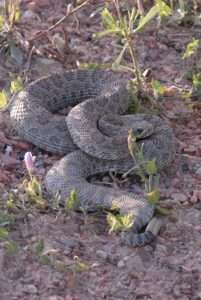We’ve all seen the headlines: “Hero dog saves owner from rattlesnake!” “Hero dog saves owner from bear!” “Hero dog saves owner from Godzilla!” (Okay, maybe not that last one.) But it’s common to see feel-good articles about how someone’s dog attacked a wild animal that was presented to the reader as a threat. Scary wild animal is routed, dog returns to have its wounds attended to by the vet, people marvel at how wonderful their dog was for protecting them.
Yet in reading these articles, I’ve found that in many of them the entire encounter could have been avoided. There are, of course, legitimate situations where a wild animal advanced on a person unprovoked. However, that’s not always the case.
Wildlife See Even Hero Dogs As Threats
 I love my dog, and I enjoy taking her out hiking. However, I am aware of the fact that wildlife view dogs as a particular type of threat, even compared to humans. Small animals, of course, recognize her as a potential large predator. But even bigger wildlife may consider her a danger to their young in the same way that coyotes and wolves are; these canine predators may hunt and kill young elk, deer, and even bear cubs if they have the opportunity. That means dogs (even small ones) can induce the same predator alarm response as their wild cousins. And remember that dogs have been used to help us hunt for thousands of years, so they haven’t lost those instincts, nor have wildlife forgotten the danger they pose.
I love my dog, and I enjoy taking her out hiking. However, I am aware of the fact that wildlife view dogs as a particular type of threat, even compared to humans. Small animals, of course, recognize her as a potential large predator. But even bigger wildlife may consider her a danger to their young in the same way that coyotes and wolves are; these canine predators may hunt and kill young elk, deer, and even bear cubs if they have the opportunity. That means dogs (even small ones) can induce the same predator alarm response as their wild cousins. And remember that dogs have been used to help us hunt for thousands of years, so they haven’t lost those instincts, nor have wildlife forgotten the danger they pose.
So a wild animal that may simply move away from a human alone may be more on guard if a dog is present. Even if all we’re doing is quietly walking on a trail, with her on a leash, I am paying extra attention to what’s going on around us, just in case. After all, I want to try to avoid being this person, who accidentally startled a mother bear and her cubs.
Here are some ways to help reduce the chance of dog-wildlife conflicts.
Leashes Save Lives
In reading these articles, I noticed a common theme: the majority of the dogs were off-leash. That makes it much more likely that the dog will charge at the wild animal, even if the animal is just walking by or standing within sight. In those cases, it is the dog that is the one starting the fight, not “defending their owner”.
 “But–but–my dog always walks off leash and stays right by me!” I’ve heard this a lot, and yet even the best-trained dogs have a point at which the temptation is too great, and they ignore their owner’s recall. In fact, here’s an article about a highly trained police K9 malinois that went missing after chasing a deer. Just because it hasn’t happened before doesn’t mean it can’t ever happen; there are a lot of “My dog has NEVER done that before!” incidents out there. Why not just make sure there never is a first time?
“But–but–my dog always walks off leash and stays right by me!” I’ve heard this a lot, and yet even the best-trained dogs have a point at which the temptation is too great, and they ignore their owner’s recall. In fact, here’s an article about a highly trained police K9 malinois that went missing after chasing a deer. Just because it hasn’t happened before doesn’t mean it can’t ever happen; there are a lot of “My dog has NEVER done that before!” incidents out there. Why not just make sure there never is a first time?
If you want to reduce the likelihood that your dog is going to start a fight with a bear, elk, raccoon, or other wild animal, keep them leashed. And leashes aren’t just important to protect wildlife from dogs, but to protect dogs from wildlife. Smaller dogs are convenient prey items for coyotes, mountain lions, and other large predatory animals. It only takes a few seconds for a small dog to wander off into the underbrush out of sight, and a leash is a great way to keep tragedy from happening.
Training Saves Lives
Another thing that happens in wildlife conflicts is that the dog will start barking and otherwise acting aggressively toward the wildlife. In this article, for example, the owner says that one of the dogs barking is likely what provoked a bear to attack. BearWise points out that the behavior that dogs commonly show when wildlife appear–barking, snapping, and lunging–is seen as a threat. That means that an animal that might have otherwise continued on its way now feels threatened and defends itself accordingly.
Yes, it’s natural for dogs to bark. However, it is possible to train a dog to stop barking, and to not jump or lunge. By training your dog a command like “Quiet” or “Hush”, and training them to stay on heel right next to you even with distractions, you are greatly reducing the perceived threat to wildlife. It’s still a very good idea to retreat away from the animal with your dog as quickly as possible rather than stand around and see if your training worked.

Finally, a special note for those of you in areas with venomous snakes: I’ve seen too many article (like this one, or this one) in which a dog ran up to a venomous snake that happened to be nearby and got bitten after “saving” their people from the snake. Snakes don’t want to start fights; instead, they’d rather have the room to retreat from danger so they don’t end up injured or killed. If you happen to step too close to a snake, the best thing you can do (as difficult as it may sound) is to stay perfectly still until the snake goes away. The absolute worst thing you can do is provoke it, and all a barking, lunging dog is doing is escalating the situation so that the snake feels it has no choice but to defend itself.
So how do you keep your dog from running up to a rattling rattlesnake or not-well-camouflaged copperhead? Snake avoidance training! By training your dog to just not go near snakes in the first place, you can help avoid them rushing in at a venomous snake and getting bitten.
Your Dog Doesn’t Need to Be a Hero
I think in an ideal world we would all want to keep our pets safe. And “Well, it’s the dog’s job” isn’t an excuse. Just because some dogs were bred to hunt or protect doesn’t mean that it’s okay to place them in circumstances where they’re unnecessarily at risk, especially when it’s possible to avoid the conflict in the first place. As thrilling as “hero dog” headlines sound, ultimately they’re all situations in which people’s pets end up in seriously dangerous conflicts with wildlife. And yes, in some cases those pets end up dying, and the wildlife may be injured or killed, too. By doing what we can to minimize the chances of these conflicts occurring in the first place, we make it more likely that our beloved furry friends stay safe and sound, as do the wild animals we share space with.
